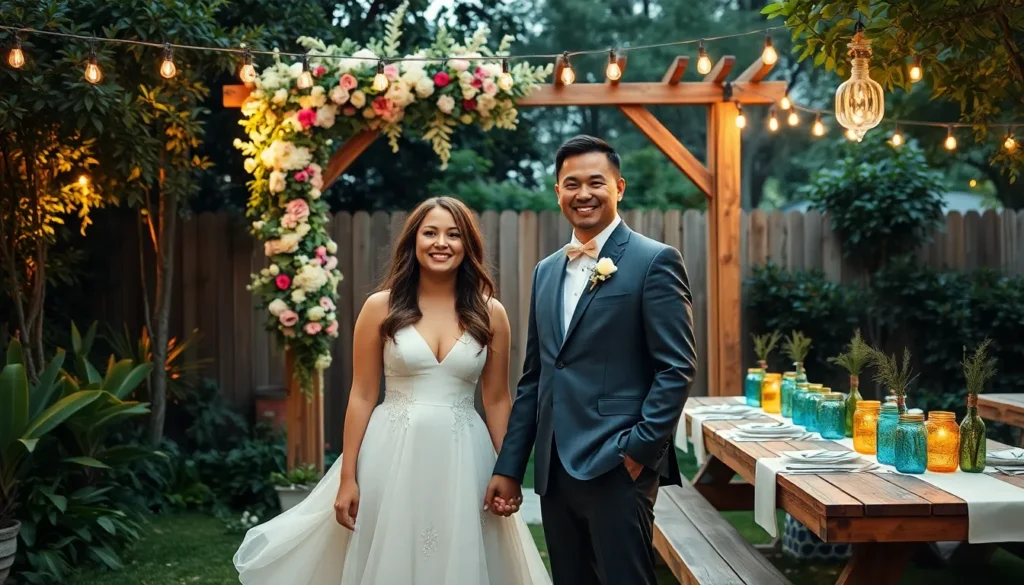We’ve all dreamed of that perfect wedding day but rising venue costs and endless planning stress can quickly turn dreams into nightmares. Home weddings are revolutionizing how couples celebrate their love story while keeping budgets intact and stress levels manageable.
Your backyard transforms into the most intimate venue imaginable where every corner holds meaning and every detail reflects your unique style. We’re seeing more couples ditch traditional venues for the comfort and flexibility that only home celebrations can provide. From garden ceremonies under string lights to cozy living room receptions you’ll discover endless possibilities right at your doorstep.
The best part? Planning a home wedding puts you in complete control of your timeline budget and guest experience. We’ll show you how to create magical moments that rival any expensive venue while saving thousands of dollars in the process.
Transform Your Backyard Into a Romantic Wedding Venue
Your own backyard offers unlimited potential for creating an enchanting wedding atmosphere that rivals any traditional venue. We’ll show you how to maximize your outdoor space for both ceremony and reception areas.
Create an Outdoor Ceremony Space with Natural Elements
Position your altar backdrop against existing trees or garden features to create a naturally stunning focal point. Large oak trees, flowering bushes, or even a simple garden wall provide the perfect foundation for your vows. We recommend incorporating seasonal flowers like peonies, hydrangeas, or wildflowers that complement your backyard’s existing landscaping.
Install a rustic wooden arch or pergola if your space lacks natural architectural elements. Simple structures made from birch branches, bamboo poles, or reclaimed wood create instant visual interest without overwhelming your garden’s beauty. Drape flowing fabric or climbing vines around these frameworks to soften hard edges and add romantic movement.
Arrange seating in curved rows or circular patterns rather than traditional straight lines to create intimate conversation spaces. Mismatched vintage chairs, wooden benches, or even hay bales covered with soft blankets encourage a relaxed, countryside atmosphere. This flexible seating approach works particularly well in smaller backyards where space optimization matters most.
Define your ceremony space using natural pathway markers like potted plants, lanterns, or scattered flower petals. Create a clear processional route from your home’s back door to the altar area using these gentle boundaries. Solar powered stake lights or mason jar luminaries can illuminate this path for evening ceremonies.
Design a Reception Area Using String Lights and Fabric Draping
Suspend café style string lights across your entire reception area to create a magical canopy effect overhead. We suggest running lights in grid patterns between trees, fence posts, or temporary poles to ensure even illumination throughout the space. Warm white LED bulbs provide the most flattering ambiance while consuming less energy than traditional incandescent options.
Layer different fabric textures and colors to define distinct areas within your reception space. Flowing chiffon, rustic burlap, or elegant silk can transform basic tables, fence lines, or pergolas into sophisticated focal points. Mix neutral tones like ivory, sage green, or dusty rose with your existing outdoor furniture and decorations.
Create vertical interest using tall centerpieces and hanging elements that draw the eye upward toward your lighting display. Elevated floral arrangements, suspended glass terrariums, or dangling crystal accents add depth without cluttering table surfaces. These elements work especially well when positioned at varying heights throughout the reception area.
Establish intimate dining clusters rather than long banquet tables to encourage conversation and movement. Round tables for six to eight guests create cozy gathering spots that feel more like dinner parties than formal receptions. Scatter these groupings across your yard to make full use of available space while maintaining comfortable traffic flow.
Set Up Weather Contingency Plans for Outdoor Celebrations
Invest in quality tent rentals that complement your backyard’s aesthetic rather than basic white party tents that look institutional. Clear top tents allow natural light while protecting against rain, while sailcloth options provide rustic charm with full weather protection. We recommend securing tents at least two weeks before your wedding date.
Prepare indoor backup locations within your home for critical wedding moments like vows or cake cutting. Clear furniture from your largest room, such as a living room or family room, to accommodate essential guests if weather forces last minute changes. Practice your ceremony logistics in this space beforehand to reduce stress on your wedding day.
Create covered areas for essential services like catering stations, gift tables, and restroom access points. Pop up canopies, market umbrellas, or even large patio umbrellas can protect these functional areas without requiring full tent installations. Position these covers strategically to maintain traffic flow between different activity zones.
Develop timeline flexibility for outdoor activities that can shift indoors or reschedule based on weather conditions. Plan cocktail hours, dancing, or games that work equally well inside or outside your home. Having multiple backup options prevents weather related stress from affecting your celebration’s overall success.
Design an Intimate Indoor Wedding Ceremony
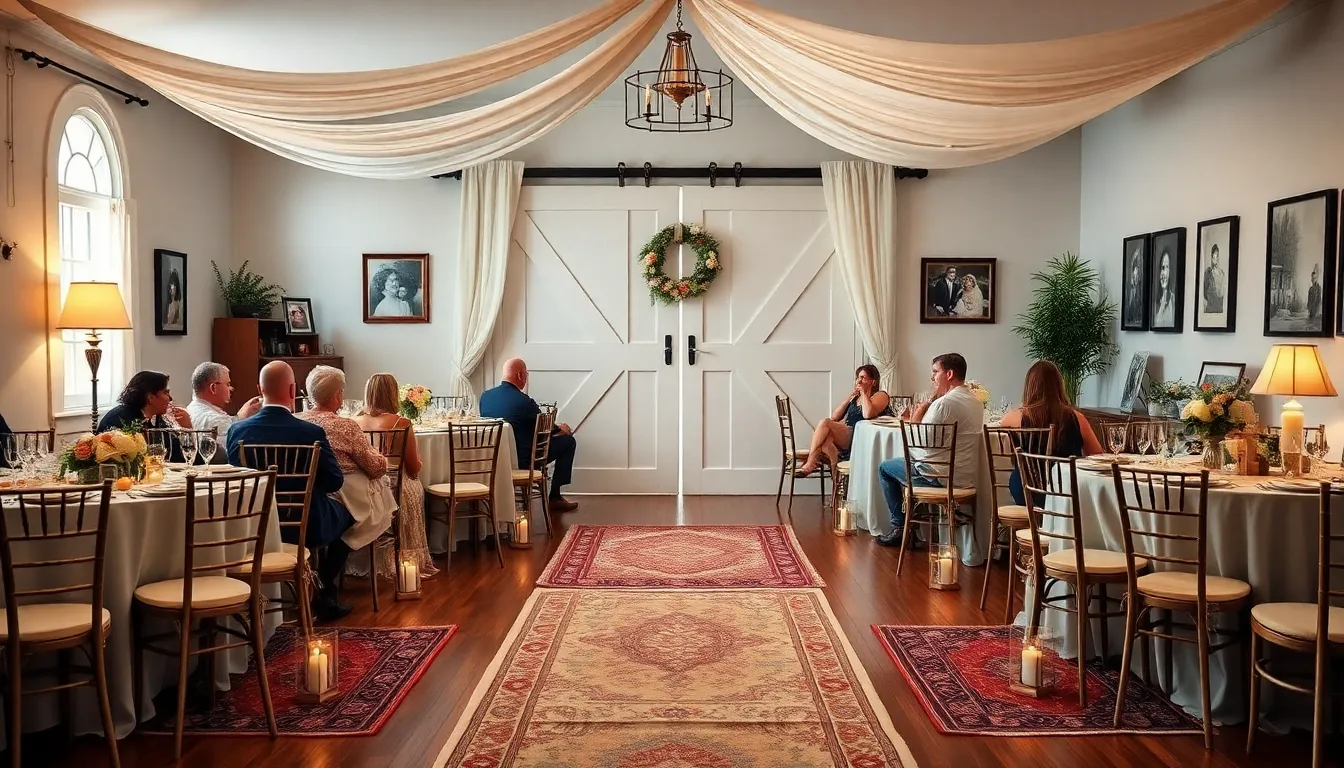
Creating a memorable wedding ceremony inside your home requires thoughtful planning and creative use of available space. We’ll show you how to transform any indoor area into a romantic venue that feels both intimate and elegant.
Maximize Small Spaces with Strategic Furniture Arrangement
Banquet tables create intimacy by seating guests close together, fostering interaction and warmth throughout your ceremony. This arrangement makes the event feel more personal and connected, as guests naturally engage with one another in the cozy setting.
Standing ceremonies work beautifully for short indoor weddings, with seating reserved only for elderly guests or those who need it. We recommend this modern approach to add informality while maximizing your available floor space for more guests.
Circular seating arrangements help everyone feel included in your special moment, creating an intimate atmosphere where all guests have clear sightlines to the ceremony. This setup works particularly well in living rooms or dining areas where traditional row seating might feel cramped.
Create a Beautiful Backdrop Using Household Items and DIY Elements
White barn doors serve as rustic backdrops when paired with wreaths and banners, adding warmth and character to your indoor ceremony space. These simple household items create a charming focal point without requiring expensive rentals or decorations.
Draped fabric transforms ordinary walls into elegant ceremony backdrops, especially when combined with floral arrangements for a romantic atmosphere. We suggest using lightweight materials like chiffon or tulle that you can easily hang from ceiling fixtures or curtain rods.
Bookshelves and mantels become ceremony altars with the addition of candles, flowers, and meaningful decorative items from around your home. These existing architectural features provide natural focal points that require minimal decoration to look stunning.
Incorporate Personal Touches with Family Photos and Heirlooms
Family photos displayed along the aisle make your ceremony feel deeply meaningful and connected to your heritage, creating a visual journey through generations of love. We recommend using matching frames or creating a gallery wall effect for maximum impact.
Heirloom pieces like antique vases and family jewelry can be incorporated into your ceremony decor, adding layers of depth and personal history to the celebration. These treasured items serve as conversation starters and help tell your family’s unique story.
Layered vintage rugs create cozy pathways down makeshift aisles, adding warmth and visual interest to hardwood or tile floors. This approach works especially well in living rooms or hallways where you want to define the ceremonial space while maintaining comfort underfoot.
Create Stunning DIY Wedding Decorations on a Budget
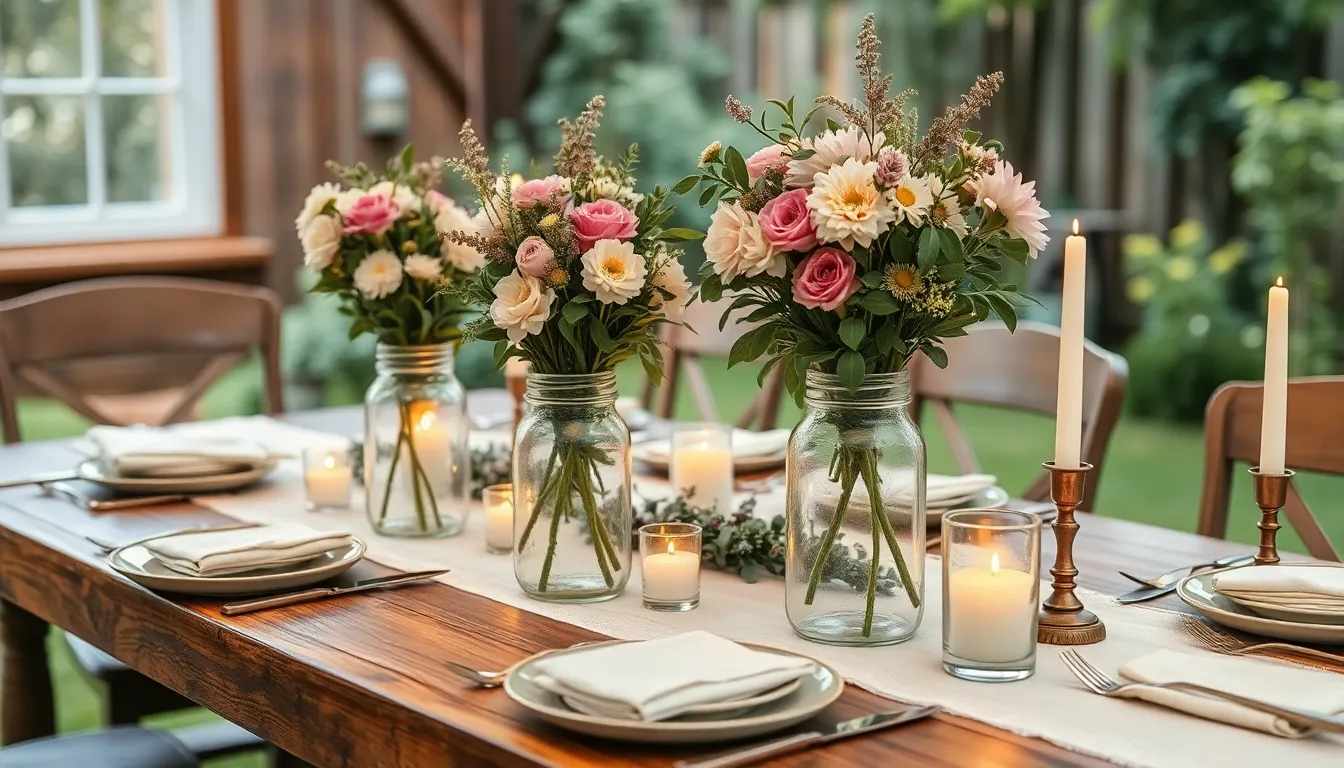
Creating beautiful wedding decorations at home doesn’t require a massive budget or professional expertise. We’ll show you how to transform simple materials into elegant wedding decor that rivals expensive professional arrangements.
Create Centerpieces Using Mason Jars and Fresh Flowers
Mason jars offer endless possibilities for creating rustic yet elegant centerpieces that perfectly complement home wedding settings. Fill these versatile containers with fresh flowers, lush greenery, or floating candles to achieve a sophisticated look without very costly. We recommend mixing different vessel types like bud vases, glass bottles, and various containers found around your house to create eclectic table arrangements that spark conversation.
Position multiple mason jars of varying heights across each table to add visual depth and interest. Combine seasonal flowers with simple greenery for a natural, organic feel that enhances your outdoor or indoor ceremony space. These DIY centerpieces cost significantly less than professional floral arrangements while providing the same stunning visual impact.
Make Paper Flower Walls and Garlands for Photo Opportunities
Paper flower walls create breathtaking backdrops for wedding photos and ceremony spaces without the expense of fresh floral installations. Create these eye-catching decorations using colorful cardstock or tissue paper, assembling them in various patterns that complement your chosen wedding theme. We suggest creating large statement walls behind your ceremony altar or smaller accent pieces throughout your reception area.
Design garlands using the same paper flower technique to drape across doorways, tables, or outdoor spaces for added visual continuity. These handmade decorations photograph beautifully and provide guests with memorable photo opportunities throughout your celebration. Pinterest and YouTube offer countless step-by-step tutorials to guide you through the crafting process, making this project accessible for any skill level.
Repurpose Everyday Items as Elegant Wedding Decor
Transforming household items into wedding decorations adds sentimental value while keeping costs remarkably low. Convert old books, vintage plates, wooden crates, or childhood toys into unique table numbers, escort card displays, and decorative accents that tell your personal story. We’ve seen couples spray paint toy cars gold and attach escort cards for playful yet elegant place holders that guests absolutely love.
Incorporate natural elements like moss and rocks to bring earthy textures indoors, creating organic centerpiece bases or pathway markers. Suspend paper lanterns at varying heights to add ambiance and visual interest to your celebration space. Create whimsical paper airplane place cards or use monogrammed containers with waterproof fairy lights to add warmth and personalization to your table settings.
Plan a Home Wedding Menu That Impresses Guests
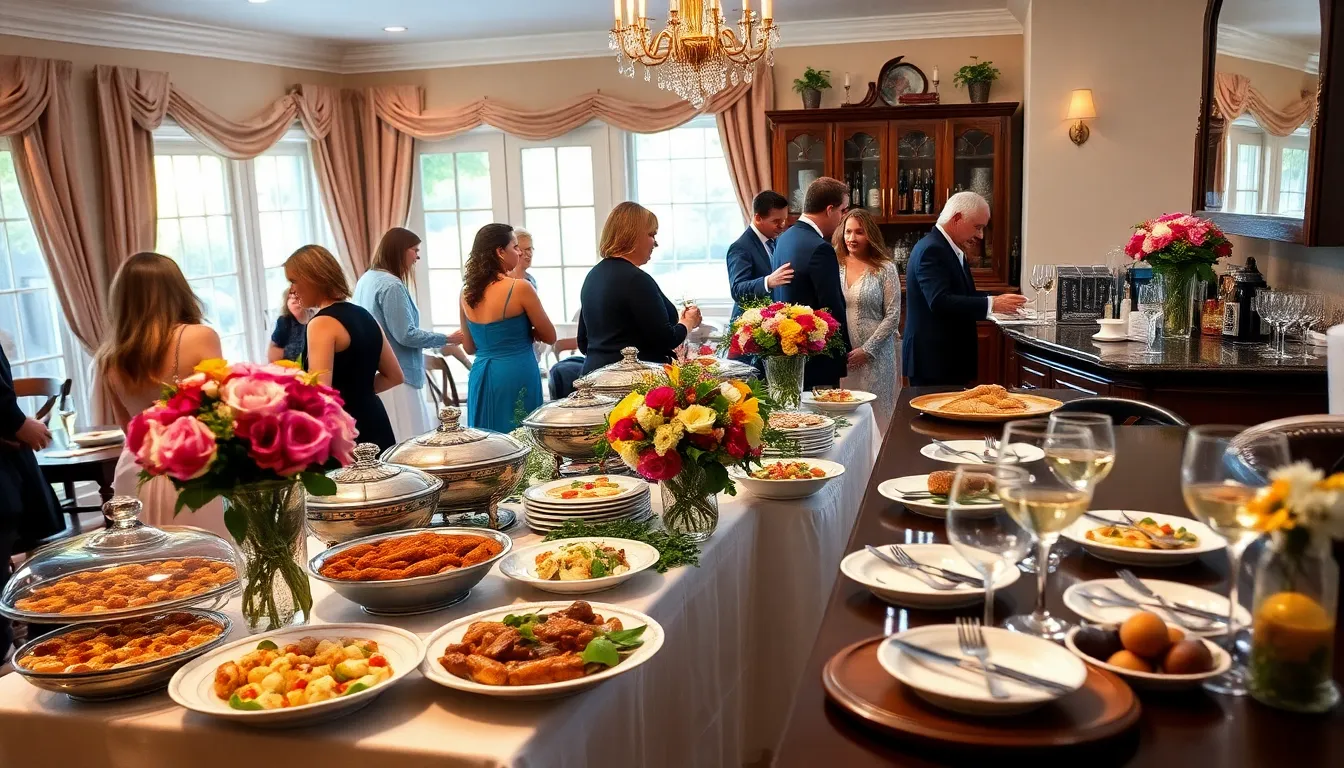
Creating an impressive home wedding menu doesn’t require professional catering when you’ve got smart planning and creative presentation. We’ll show you how to transform your home into a culinary destination that delights every guest.
Design a Buffet-Style Reception Using Your Kitchen and Dining Room
Transform your kitchen and dining room into elegant buffet stations that create natural flow throughout your home wedding reception. Position your main dishes in the kitchen where guests can easily access serving utensils and plates while keeping desserts and appetizers in the dining room for better traffic management.
Arrange dishes in logical order starting with appetizers like prosciutto wrapped peaches and shrimp cocktail, followed by main courses such as spicy shrimp etouffee and red beans and rice with spicy sausage. Vegetarian options including roasted vegetable salads and eggplant with smoked mozzarella tart should have their own dedicated section to accommodate dietary preferences.
Create visual appeal using flowers, candles, and coordinating linens that tie your buffet setup together seamlessly. Elevate serving dishes on cake stands or decorative boxes to add height variation while ensuring each dish remains easily accessible to guests of all ages.
Establish clear pathways between your kitchen and dining room buffet areas to prevent bottlenecks during peak serving times. Label each dish clearly so guests can make informed choices while moving efficiently through your carefully planned buffet flow.
Create Signature Cocktails with a Home Bar Setup
Design a memorable home bar using a corner of your dining room or designated outdoor area with essential mixers, juices, and garnishes that complement your wedding theme. Stock your bar with ingredients for signature drinks like refreshing summer spritzers or unique moonshine cocktails that reflect your personal taste as a couple.
Set up your bar station with proper glassware, cocktail napkins, and attractive signage that lists your signature drinks and their ingredients. Include both alcoholic and non-alcoholic options to ensure every guest finds something appealing throughout your home wedding celebration.
Organize your bar supplies in decorative containers or vintage serving trays that add visual interest while keeping everything accessible to your designated bartender. Fresh garnishes like citrus wheels, mint sprigs, and berries should be prepared in advance and stored in attractive glass bowls.
Create a self-serve element for simple drinks like wine and beer while reserving your signature cocktails for personalized service that adds an interactive element to your home wedding reception.
Coordinate Potluck-Style Dishes with Family and Friends
Coordinate with family and friends by assigning exact dish categories to each guest, ensuring variety across meat, vegetarian, and dessert options that complement your planned menu. This approach reduces your cooking workload while involving loved ones in your special day’s culinary success.
Plan potluck contributions strategically by requesting dishes like vegetable curry, bacon wrapped dates, or cucumbers with hummus that travel well and maintain their quality during your celebration. Provide guests with exact serving size guidelines to ensure adequate portions for your expected guest count.
Organize dish identification using attractive labels or signs that list each contribution along with the contributor’s name, creating conversation starters while helping guests with dietary restrictions or allergies. This system also ensures proper recognition for everyone’s culinary contributions to your home wedding feast.
Establish pickup and serving protocols by designating exact arrival times for potluck dishes and providing warming instructions to maintain food safety and quality throughout your reception. Coordinate with contributors about bringing their own serving utensils to ensure smooth buffet operations.
Set Up Professional Photography Areas in Your Home

Creating dedicated photography areas ensures you’ll capture stunning wedding memories without hiring expensive professional photographers. We’ll transform your home into a picture-perfect backdrop that rivals any traditional venue.
Choose the Best Lighting Locations for Wedding Photos
Natural light creates the most flattering and professional-looking wedding photos. We recommend positioning your ceremony and reception areas near large windows or glass doors where soft, diffused light naturally filters in. Gardens and outdoor spaces provide excellent lighting opportunities, especially during golden hour when the sun creates a warm, romantic glow.
Indoor areas with good natural light serve as perfect backup options when weather doesn’t cooperate. We suggest identifying rooms with multiple windows or skylights that offer consistent lighting throughout the day. Your photographer can help determine which areas provide the best light quality at different times, ensuring every shot looks professionally lit.
Front door areas often receive beautiful natural light and create classic photo opportunities. We’ve found that positioning couples near entryways with good overhead lighting or side lighting produces stunning portrait results.
Create Multiple Photo Backdrops Throughout Your Property
Variety in your photo locations keeps your wedding album interesting and ever-changing. Gardens offer natural beauty with flowers, trees, and greenery serving as organic backdrops that change with the seasons. We recommend using different sections of your yard to create distinct looks, from intimate close-ups against flowering bushes to wide shots showcasing your industry.
Props add creativity and personality to your wedding photos without breaking the budget. Vintage doors, antique furniture, or decorative lanterns create unique focal points that reflect your style. We suggest gathering items like old wooden chairs, vintage suitcases, or family heirlooms to incorporate meaningful elements into your shots.
Barn areas or rustic structures provide textured backdrops perfect for country-style weddings. Natural elements like hay bales, wooden fences, or stone walls add character and depth to your photos while maintaining an authentic, homespun feel.
Designate Exact Areas for Group Photos and Portraits
Group photos require spacious areas where everyone can be seen clearly and comfortably arranged. We recommend choosing locations with enough room for your largest anticipated group, whether that’s immediate family or your entire guest list. Open areas in your backyard, large living rooms with furniture moved aside, or covered patios work excellently for these shots.
Portraits need quieter, more intimate settings that allow couples to connect naturally. We suggest identifying secluded corners of your garden, cozy indoor nooks with beautiful natural light, or peaceful areas away from reception activities. These spaces should have simple, uncluttered backgrounds that won’t distract from the subjects.
Well-lit areas ensure your group photos and portraits look professional and clear. We recommend testing different locations at various times of day to determine when each area receives the most flattering light, then scheduling your photo sessions accordingly.
Manage Guest Logistics for Home Wedding Celebrations
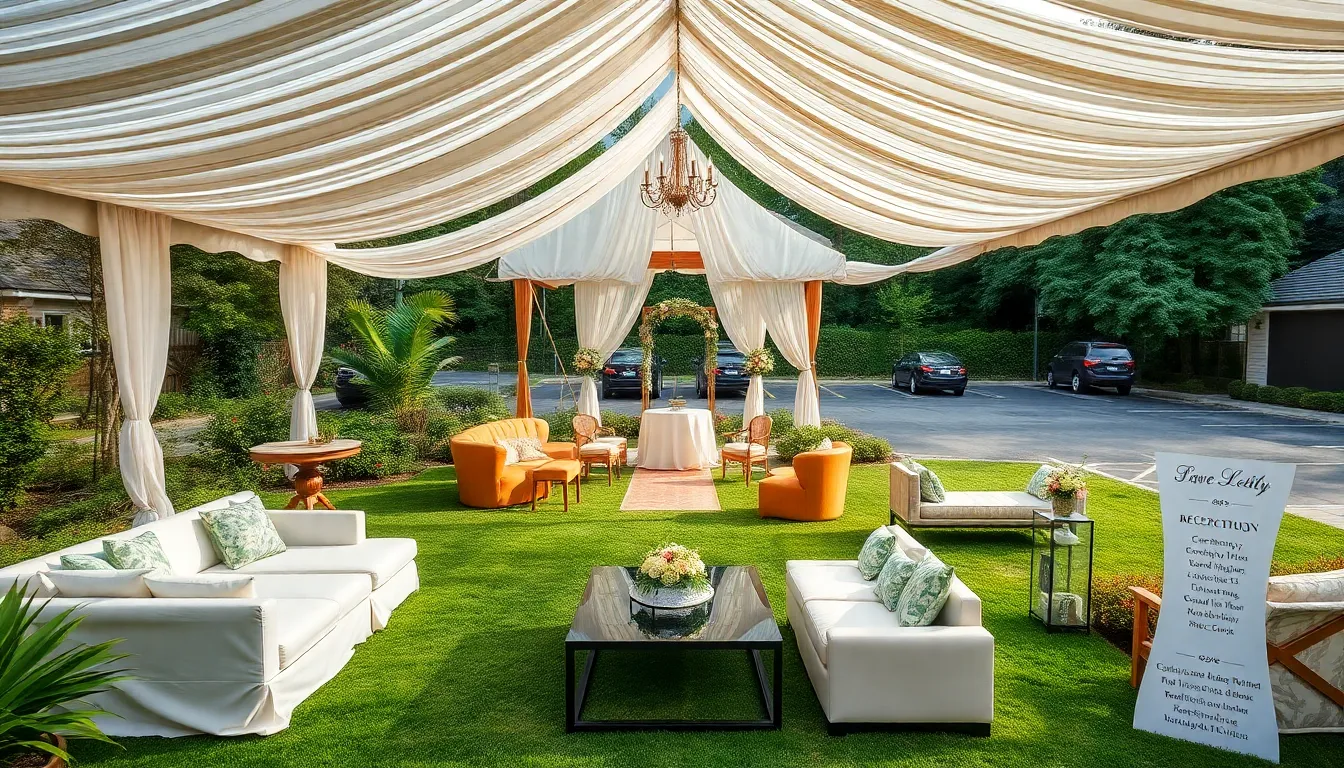
Managing guest logistics becomes crucial when transforming your home into a wedding venue. We’ll help you create smooth transportation coordination and comfortable experiences that keep your celebration flowing seamlessly.
Plan Parking Answers for Wedding Day Traffic
Consider off-site parking with shuttle services to reduce congestion near your home. Local community centers, schools, or nearby businesses often allow event parking on weekends. Shuttle services create a premium experience while protecting your neighborhood from traffic overload.
Hire parking attendants to manage vehicle flow and direct guests efficiently. Professional attendants can handle 50-75 cars per hour during peak arrival times. They’ll ensure handicapped parking remains accessible and prevent guests from blocking driveways or fire hydrants.
Reserve street parking by coordinating with neighbors and local authorities. Contact your city hall about temporary parking permits if needed. Post clear signage 24 hours before your wedding to reserve spaces for your guests.
Create a parking map showing designated areas and alternative locations. Include this map in your wedding website updates and welcome bags. Digital updates through your wedding website reach 85% of guests more effectively than traditional mailings.
Create Comfortable Seating Arrangements in Limited Space
Use seating charts to optimize every square foot while ensuring guest comfort. Strategic placement can increase seating capacity by 20-30% compared to random arrangements. Group family members and friends with similar interests to encourage natural conversation flow.
Expand seating to outdoor areas using tents or canopies for weather protection. Quality tent rentals provide 15-20 square feet per person for comfortable dining. String lights and fabric draping transform covered areas into elegant dining spaces.
Carry out mixed seating options including cocktail tables, lounge areas, and traditional dining tables. Standing cocktail tables accommodate 25% more guests in the same space. Lounge furniture creates intimate conversation areas that feel more relaxed than formal seating.
Position seating in clusters rather than long rows to maximize space efficiency. Circular arrangements work better in small rooms than traditional rectangular layouts. This approach creates multiple focal points and prevents guests from feeling cramped.
Organize Guest Flow Between Ceremony and Reception Areas
Create clear signage with arrows and directional markers to guide movement between spaces. Professional signage reduces guest confusion by 60% during transitions. Use consistent fonts and colors that match your wedding theme for cohesive branding.
Develop a detailed flow plan to prevent congestion during key transition moments. Brief hotel staff and transportation providers about timing if guests are staying at nearby accommodations. Direct contact between vendors ensures smooth coordination throughout your celebration.
Designate exact pathways that separate arriving guests from those already seated. One-way traffic patterns work best during ceremony seating. Create alternative routes for vendors and wedding party members to avoid disrupting guests.
Communicate schedules through multiple channels including printed materials in welcome bags and mobile alerts. Digital updates reach guests instantly while printed schedules serve as backup references. This dual approach ensures 95% of guests receive important timing information.
Handle Legal Requirements and Permits for Home Weddings
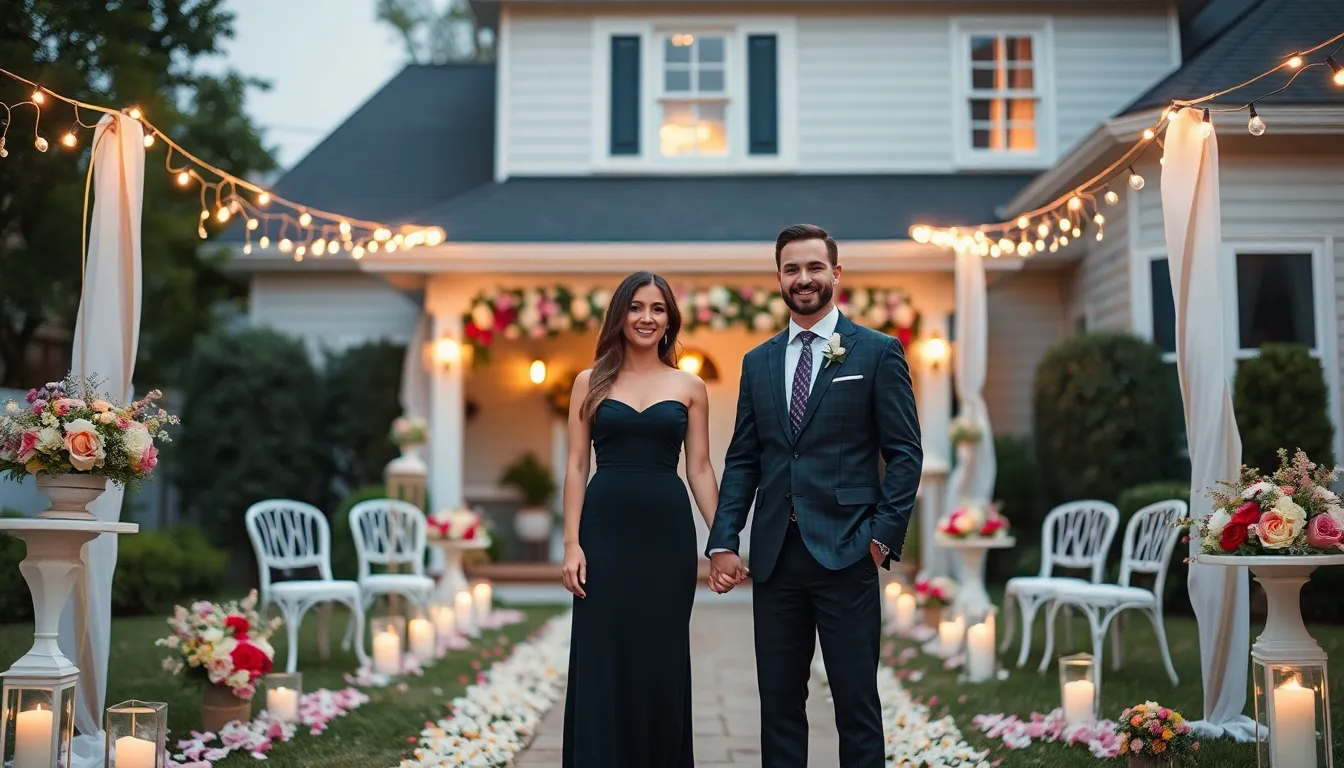
Planning a home wedding involves handling exact legal requirements that can vary significantly by location. We’ll walk you through the essential steps to ensure your celebration complies with local laws while maintaining the intimate atmosphere you desire.
Research Local Regulations for Home-Based Events
Understanding local regulations forms the foundation of legally compliant home wedding planning. Each city and county maintains different requirements for private events, so we recommend contacting local authorities directly to verify compliance standards. Municipal offices typically provide exact information about noise ordinances that restrict sound levels during certain hours, parking restrictions that limit street usage, and zoning laws that affect both event size and duration.
Residential areas often have stricter guidelines than commercial districts. Property size, guest count, and event timing all factor into regulatory compliance requirements. We suggest creating a checklist of local restrictions early in your planning process to avoid last-minute complications.
Obtain Necessary Permits for Larger Gatherings
Securing appropriate permits becomes essential when hosting gatherings that exceed standard residential use. Special event permits are typically required for celebrations featuring live music, catered food service, or alcohol consumption. These permits often require advance applications with detailed event descriptions and timeline specifications.
Tent permits demand additional documentation if you’re installing temporary structures on your property. Local authorities usually require detailed plans showing exit locations, fire extinguisher placement, and structural specifications for any temporary installations. Zoning permits may be necessary to waive residential restrictions, particularly in neighborhoods with strict homeowner association guidelines or municipal zoning requirements.
| Permit Type | Application Timeline | Required Documentation | Average Cost Range |
|---|---|---|---|
| Special Event | 2-4 weeks advance | Guest count, timeline, vendor list | $50-$200 |
| Tent Installation | 1-2 weeks advance | Structural plans, safety equipment list | $25-$150 |
| Zoning Variance | 4-6 weeks advance | Property survey, event details | $100-$500 |
Coordinate with Neighbors About Wedding Day Activities
Building positive relationships with neighbors prevents potential conflicts and ensures community support for your celebration. We recommend approaching neighbors personally to discuss your wedding plans, including expected noise levels during different portions of the event and exact timing for louder activities like live music or dancing.
Parking arrangements require careful coordination to prevent neighborhood congestion and maintain emergency vehicle access. Consider providing neighbors with guest parking maps showing designated areas and restricted zones. Offering small tokens of appreciation, such as wedding favors or dessert plates, helps maintain goodwill throughout the planning process.
Additional insurance considerations include reviewing your current liability coverage to determine if it extends to event hosting. Many homeowners find that purchasing special event insurance provides additional protection for their celebration and peace of mind for the wedding day.
Conclusion
Planning a home wedding opens up endless possibilities for creating a celebration that’s uniquely yours. We’ve shown you how to transform any space into a romantic venue while keeping costs manageable and stress levels low.
The beauty of home weddings lies in their flexibility and personal touch. From DIY decorations to creative menu planning and strategic photography setups every element can reflect your personality and style.
Remember that successful home weddings require thoughtful planning especially when it comes to guest logistics and legal requirements. With proper preparation and the right permits you’ll create an unforgettable celebration that rivals any traditional venue.
Your home wedding can be just as magical as any destination celebration while offering the comfort and intimacy that only your own space can provide.
Frequently Asked Questions
What are the main benefits of having a home wedding?
Home weddings offer significant cost savings, complete control over your budget, and the ability to create a deeply personal celebration. You can customize every detail to reflect your unique style, eliminate venue restrictions, and create an intimate atmosphere that traditional venues often can’t match. Plus, you have the flexibility to extend your celebration over multiple days.
How can I transform my backyard into a romantic wedding venue?
Create an outdoor ceremony space using natural elements like trees as altar backdrops or wooden arches. Arrange seating in intimate clusters and use string lights with fabric draping for magical ambiance. Add vertical elements for visual interest and always have weather contingency plans, including quality tent rentals and indoor backup locations.
What are some creative ideas for indoor home wedding ceremonies?
Transform indoor spaces by using strategic furniture arrangements like banquet tables for intimacy or circular seating for inclusivity. Create beautiful backdrops with white barn doors, draped fabric, or repurposed bookshelves. Add personal touches with family photos and heirlooms, and use layered vintage rugs to create cozy pathways.
How can I create stunning DIY wedding decorations on a budget?
Use mason jars filled with fresh flowers and greenery for rustic centerpieces. Create paper flower walls and garlands for photo backdrops using online tutorials. Repurpose everyday items like old books and vintage plates into unique decor. These DIY elements add sentimental value while keeping costs significantly lower than professional decorations.
What’s the best way to plan a home wedding menu without professional catering?
Design a buffet-style reception using your kitchen and dining room, arranging dishes logically with decorative elements. Set up a home bar with signature cocktails and coordinate potluck-style contributions from family and friends. This approach reduces your workload while creating a diverse, memorable culinary experience for guests.
How can I capture professional-quality wedding photos at home?
Position ceremony and reception areas near large windows or outdoor spaces for optimal natural light. Create multiple photo backdrops throughout your property using props for creativity. Designate specific areas for group photos and intimate portraits, ensuring well-lit and spacious locations to achieve professional-looking results without expensive photographers.
What should I consider for guest logistics at a home wedding?
Coordinate transportation with off-site parking options and shuttle services to prevent congestion. Consider hiring parking attendants and reserving street parking for efficient vehicle flow. Create comfortable seating arrangements that optimize guest interaction, and organize clear guest flow between ceremony and reception areas using detailed signage and flow plans.
Do I need permits for a home wedding?
Permit requirements vary by location and guest count. Research local regulations and obtain necessary permits for larger gatherings well in advance. Common permits include noise, occupancy, and parking permits. Coordinate with neighbors to prevent conflicts and consider additional insurance for peace of mind. Application timelines typically range from 2-8 weeks.

